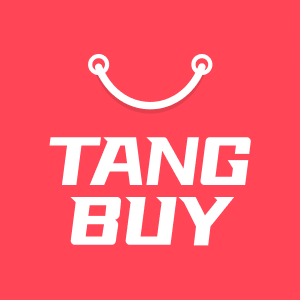How to Grow Your Dropshipping Business from First Sale to International Success
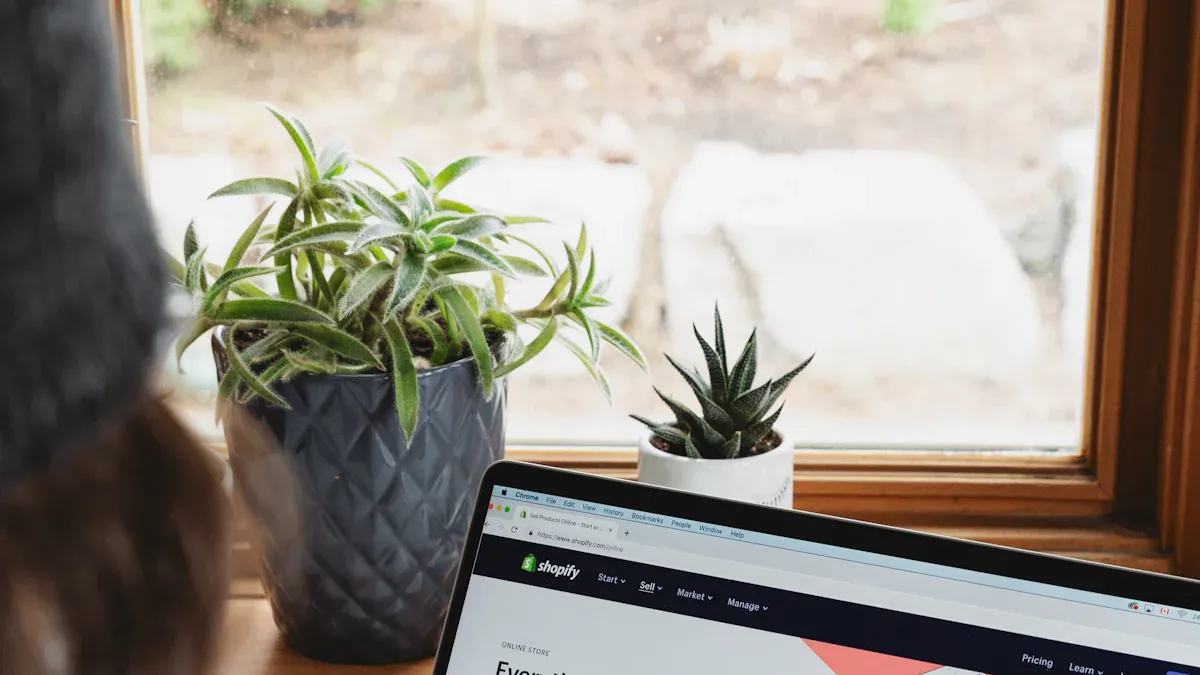
Growing your dropshipping business takes time, effort, and smart planning. You’ll face obstacles along the way, but you’re not alone. Many successful brands started with just one sale and built from there. Let’s look at some challenges you might meet in your first year:
Market research can be tricky, especially when you’re learning about your competition.
Suppliers sometimes let you down with slow shipping or poor product quality.
Customer service matters. If you ignore it, you lose trust and repeat business.
Your online shop needs to look professional, with clear value and easy checkout.
Your dropshipping journey calls for patience and action. You’ll learn how to avoid these common mistakes and use proven strategies.
Key Takeaways
Try to find the right customers for your shop. Make your product pages easy to understand. This helps you get your first sale.
Pick suppliers you can trust. Test products before selling them. Check reviews to make sure there are no problems with shipping or quality.
Build a strong brand that stands out. Choose a clear niche for your shop. Use the same style and colours everywhere. Give good customer service people can trust.
Use automation tools to help you save time. These tools also help you make fewer mistakes as your business gets bigger.
Make a marketing funnel that brings people to your shop. Help visitors learn more about your products. Encourage them to buy again.
Change your shop and ads for customers in other countries. This helps people trust you and can help you sell more.
Watch important data like sales and what customers do. Use this information to make your shop and ads better.
Do not try to grow too fast. Focus on your best products. Listen to what your customers say to improve your shop.
Foundation
First Sale
Milestone
Getting your first sale feels great. It is a big moment. It means your hard work is starting to pay off. Many new dropshippers ask how to reach this point. You should focus on some important things:
Find the right people so your marketing works better.
Show customer reviews to help people trust your shop.
Make your product pages look nice with clear pictures and good details.
Write a blog to get more visitors and show you know your topic.
Give out coupons or discounts to make people buy now.
Hold contests or giveaways to get more attention and fans.
Use ads on Google, Facebook, or Instagram to find more buyers.
Work with influencers to make your brand look trustworthy.
Send emails to remind people about their baskets or special offers.
Share video reviews so people can see your products better.
Make your website faster so people do not leave before buying.
Pick one main product to keep your message simple.
Try different ads and pages to see what works best.
Make your shop easy to find on search engines for free visitors.
Use urgency tricks and share on sites like Pinterest.
Add an FAQ page and make your website look better for users.
Persistence
Getting your first sale might take a while. Some people see results in weeks. Others need a few months. Keep testing your marketing and making your website better. Learn about your audience. Hard work pays off. Most dropshipping shops make money after six months to a year. Do not quit if things are slow at first.
Basics
Legal
Setting up your business the right way keeps you safe and helps people trust you. You should:
Pick a legal structure, like sole trader or limited company, to protect your things.
Register your business and get any licences you need.
Add legal pages to your website, like Terms and Conditions and Privacy Policy.
Make sure your products and ads follow the law.
Collect and pay sales tax if you have to.
Protect your brand by using your own content and avoiding copyright problems.
Suppliers
Good suppliers are very important for your dropshipping shop. Here is how to choose the best ones:
Try product samples yourself to check quality and delivery speed.
Talk to suppliers to see if they reply quickly and clearly.
Read reviews on sites like Trustpilot or Alibaba.
Check their business papers and certificates.
Look at their return and refund rules.
Start with small orders before you order more.
Watch out for bad signs like hidden costs, slow replies, or not giving samples.
Setup
Platform
Picking the right platform makes running your shop easier. Here is a quick look at some popular choices:
Platform | Key Features and Description |
|---|---|
DSers | Lets you import products from AliExpress automatically. |
AliExpress | Has many cheap products to choose from. |
SaleHoo | Directory with checked suppliers and business tools. |
Spocket | Connects you with suppliers in the US and EU. |
Wholesale2B | Over 1 million products, works with Shopify, eBay, Amazon. |
Doba | 2 million products, helps with stock and order tracking. |
Modalyst | High-quality US/EU products, orders are filled automatically. |
Inventory Source | Over 180 suppliers, helps with stock and order management. |
Dropified | Works with Shopify, WooCommerce, BigCommerce. |
Wholesale Central | Directory with over 1 million products. |
Finances
You do not need lots of money to start dropshipping, but you need a plan. Most people spend about $300 to $400 to begin. This pays for business registration, website fees, marketing, and supplier costs. If you want to grow bigger, costs can go over $3,000. Remember to plan for extra costs like payment fees and app subscriptions.
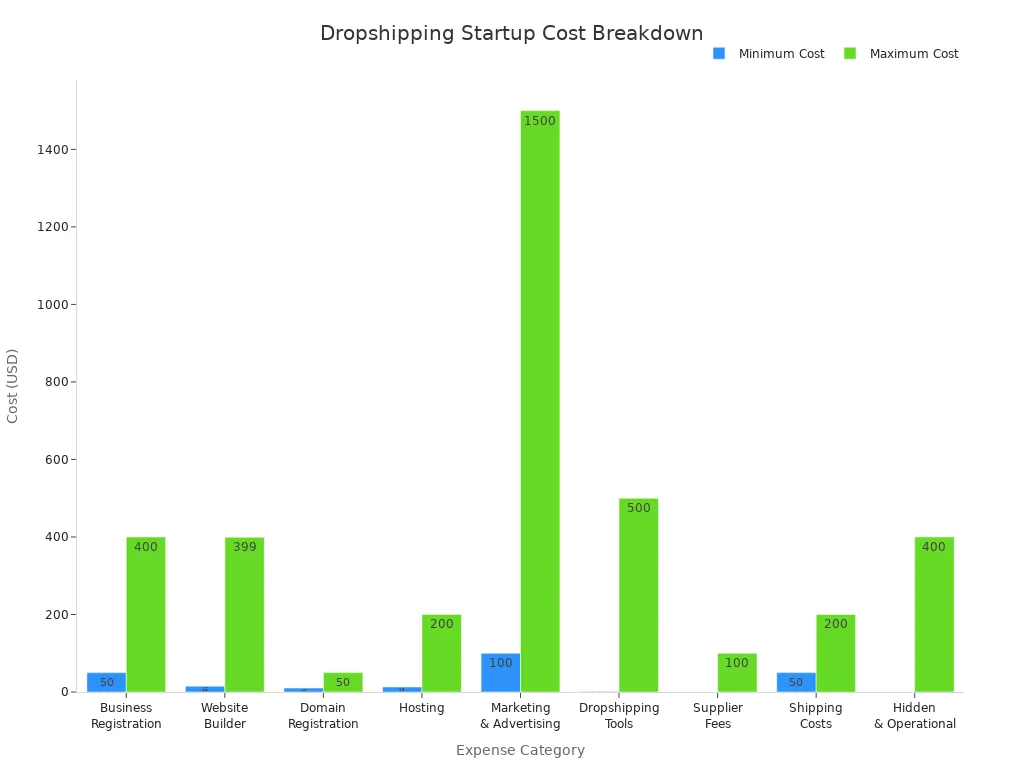
Tip: Write down every cost from the start. Good records help you find problems early and keep your business healthy.
Brand
Identity
Niche
Choosing your niche shapes your dropshipping journey from the start. When you pick a focused niche, you stand out in a crowded market. You avoid fighting for attention with every other shop selling the same products. Instead, you speak directly to a group of people who care about what you offer. This makes your marketing easier and your message clearer.
A well-chosen niche lowers your advertising costs and boosts your conversion rates.
You build loyalty because your customers feel understood.
You avoid problems like thin profit margins and high return rates.
You can spot trends and match your products to what people want.
Take your time to research. Look for a balance between demand, competition, and supplier options. If you get your niche right, you set yourself up for long-term growth.
Visuals
Your brand visuals help people remember you. Think about your logo, colours, and the style of your website. These elements work together to create a first impression. A strong visual identity makes your shop look professional and trustworthy.
Tip: Use the same colours, fonts, and logo everywhere—on your website, social media, and emails. Consistency helps people recognise your brand.
A memorable brand name and a clear logo make you stand out. Good visuals also let you charge higher prices because people see more value in your shop. Even if you sell the same products as others, your brand can feel unique.
Trust

Service
Great customer service keeps people coming back. When you answer questions quickly and solve problems, you show that you care. Customers want to feel safe when they buy from you. If you handle returns smoothly and offer fast refunds, you build trust.
Give clear product details to help customers make good choices.
Follow up after a sale to thank buyers and ask for feedback.
Happy customers often tell their friends about your shop. This word-of-mouth can bring in new buyers and boost your reputation.
Credibility
Trust is the heart of your brand. People spend more with brands they trust. You can build credibility by:
Using a professional website with a clear domain name.
Showing real customer reviews and photos.
Sharing your story and values to connect with your audience.
Keeping your website free from errors and broken links.
You can also try sending postcards or thank-you notes. Physical mail stands out and makes your brand feel more real.
Voice
Your brand voice is how you talk to your customers. It shows your personality and values. When you use the same tone everywhere, people start to recognise and trust you. A friendly, honest voice makes your shop feel welcoming.
Share your story and what makes your shop special.
Listen to your customers and use their feedback to improve.
Keep your language simple and clear.
Use the same style in your emails, product pages, and social posts.
A strong brand voice helps you build emotional connections. Customers remember how you make them feel. If you stay true to your voice, you turn buyers into loyal fans.
Dropshipping Journey
Your dropshipping journey does not end after your first sale. This is only the start. As you keep going, you will meet new problems and bigger chances. You can grow your shop, build a team, and set up marketing funnels that turn visitors into loyal customers.
Scaling
Automation
Scaling your dropshipping journey means more orders and more products. You will also have more customers. Doing everything by hand is slow and causes mistakes. Automation helps you work faster and better.
You can use tools like Klaviyo or Mailchimp to send emails for you. These tools welcome new customers, remind people about their baskets, and share special offers.
Zapier links your apps together. When someone orders, Zapier sends details to your support team or updates your stock.
Shopify Flow lets you set rules for your shop. When you get an order, it can update your stock or send a thank-you email.
Supplier integration tools like Spocket and AliDropship help you import products, sync stock, and fill orders without doing it yourself.
Apps like Auto DS, Dropified, and Oberlo can send orders to suppliers, update order status, and send shipping messages.
Automation saves you time and stops mistakes. You can grow your business instead of fixing problems.
Real-time syncing of stock and prices keeps your shop correct. Customers trust you more when you do not oversell or make price mistakes. As your dropshipping journey grows, automation helps you the most.
Team
You might start your dropshipping journey alone, but you cannot do everything forever. Building a team helps you grow faster and keeps your business running well.
Clear talking stops mistakes and missed orders. Use tools like Slack or Trello to keep everyone organised.
Flexibility matters. Let your team work from home or pick their hours if possible. People feel happy and stay longer.
Encourage teamwork. Run workshops or set up mentors so your team learns from each other.
Give feedback often. Regular chats help fix problems early and keep everyone happy.
Share jobs wisely. Use automation for boring tasks and let your team do what they are best at.
A strong team helps you manage orders, talk to customers, and work with suppliers. You avoid burnout and keep your dropshipping journey moving forward.
Funnels
Marketing
A successful dropshipping journey needs a strong marketing funnel. This funnel guides people from first hearing about your shop to becoming loyal customers.
At the top, you bring in visitors with SEO, social media, and paid ads. Use blogs, Instagram posts, and influencer shoutouts to get noticed.
In the middle, you help leads. Send personal emails, answer questions, and share useful content. Show why your products are the best choice.
At the bottom, you get people to buy. Offer discounts, free shipping, or short-time deals. Make your checkout easy and quick.
After the sale, keep in touch. Use loyalty programmes and special offers to turn one-time buyers into repeat customers.
Track your results with tools like Google Analytics. Look at conversion rates and customer feedback. Change your funnel to fix weak spots and boost sales.
Hooks
You need strong hooks to grab attention and get sales during your dropshipping journey. Hooks are special offers, messages, or content that make people stop and act.
Run giveaways with your best-selling products. After the contest, send discount codes to everyone who joined.
Join online groups like Facebook or Reddit. Share tips and answer questions to build trust.
Use video marketing. Show your products in action, share unboxing videos, or make how-to guides.
Post on social media with trending hashtags and effects. Ask customers to share their own photos and stories.
Write blog articles with keywords your audience looks for. Help people solve problems and find your shop.
Send personal emails with special deals or product ideas.
Work with influencers who fit your niche. Honest reviews and shoutouts can boost your trust.
Tip: Always use clear product descriptions, good images, and honest messages. Do not use misleading ads to keep your brand trustworthy.
Real-World Success Stories
Many brands started their dropshipping journey small and grew into global names. Here are some inspiring examples:
Brand | How They Started | Where They Are Now |
|---|---|---|
Gymshark | Ben Francis began in the UK, dropshipping fitness supplements before designing his own clothes. | Now a £1 billion fitnesswear brand with global reach. |
Kylie Cosmetics | Kylie Jenner used dropshipping to launch her cosmetics line on Shopify, skipping warehouses. | Over £150 million yearly revenue, global presence. |
Grafomap | Used print-on-demand dropshipping for custom map posters, focusing on marketing and SEO. | Grows worldwide with millions in revenue. |
Wallplate Warehouse | Adam Greenspan started dropshipping decorative switch plates, focusing on a niche market. | Now a top brand, competing with Amazon worldwide. |
These brands show your dropshipping journey can lead to international success. Start small, use smart tools, build a great team, and always improve your marketing funnel. Every big brand started with one sale—yours could be next.
Marketing

Digital
Ads
Paid ads help your dropshipping business grow fast. You can show ads on Facebook, Instagram, TikTok, and Google. These sites let you pick who sees your ads by age and interests. You can also target people by what they like to buy. Use clear pictures and easy words in your ads. Show why your product is good. Retargeting ads remind people about your shop if they leave. This can help you get back lost sales.
Many dropshippers get quick results with paid ads. If you run ads well, you can sell more and spend less. Good ad managers try different groups and ad styles. They look for what works best. They also watch your budget so you do not waste money. Keep testing and changing your ads often. This helps you get more clicks and better results for your money.
Tip: Begin with a small budget. Check your results and change your ads often. This helps you grow what works and not lose money.
Influencers
Working with influencers can help more people see your brand. Influencers have fans who trust what they say. When they talk about your products, people listen. Micro-influencers have fewer fans but they talk to them more. They often give you the best value for your money.
Benefit | How It Helps Your Brand |
|---|---|
Trust and Credibility | Followers trust influencer opinions, which builds your brand’s credibility. |
Targeted Reach | You reach the right people who are interested in your niche. |
High Engagement | Influencer posts get more likes, comments, and shares. |
Social Proof | Endorsements make your shop look popular and reliable. |
Pick influencers who fit your brand values. Set clear goals for each campaign, like more sales or more followers. Give rewards like free products or a share of sales to keep influencers happy.
Global
Targeting
If you want to sell in other countries, choose your markets with care. Look for places where people shop online a lot and pay easily. Pick niche markets so you do not have too much competition. Use social media, SEO, and influencers to find new buyers in these places.
Learn about how people shop and pay in each country. Some use credit cards, others use digital wallets. Offer the right ways to pay so checkout is easy. Work with local suppliers if you can. This makes delivery faster and builds trust.
Note: Giving customer support in local languages helps you stand out and keeps buyers happy.
Localisation
Localising your marketing means more than just changing words. You need to change your pictures, products, and payment ways for each place. Most people like to shop on sites in their own language. Use local SEO so people in each country can find you.
Many e-commerce platforms let you add language and money choices. Make sure your ads and product details fit the local culture. Use data tools to see what works in each market and change your ads.
Change your website and ads for each country.
Offer local ways to pay so people finish buying.
Use AI translation tools, but always check if they fit the culture.
Spending time on localisation helps people trust you and helps your dropshipping business grow in new countries.
Logistics
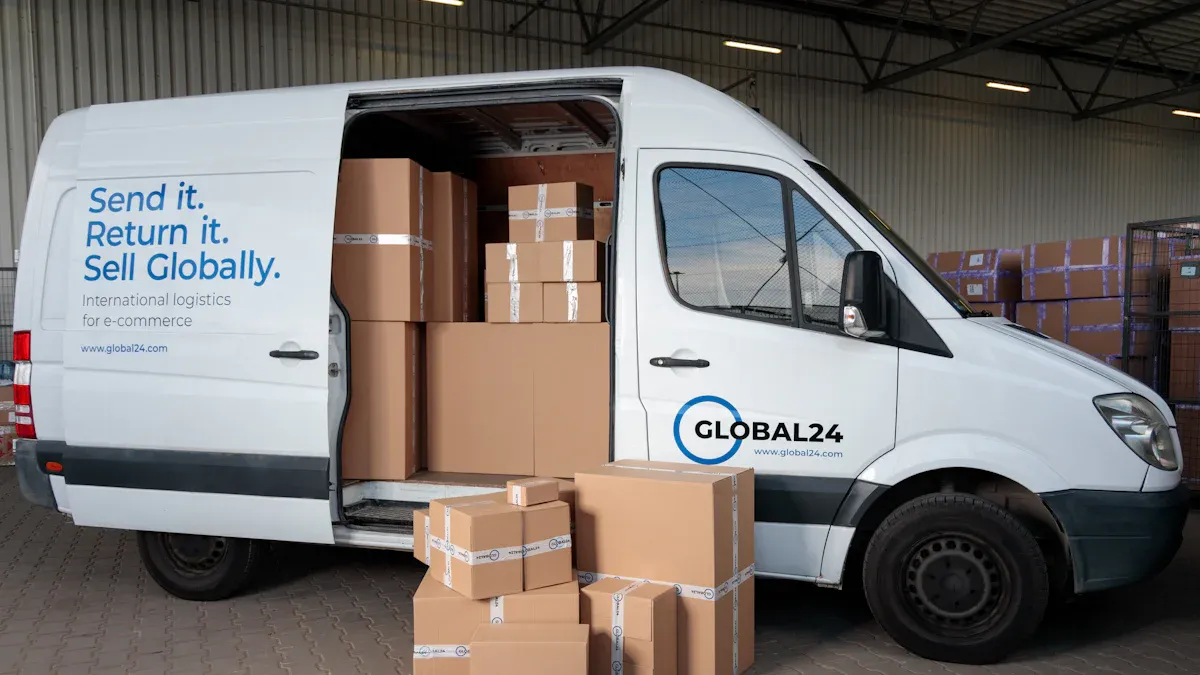
Logistics is very important for your dropshipping business. It matters even more when you want to sell in other countries. If you do logistics well, your customers stay happy. Your brand will also look strong. Here is what you should know.
Suppliers
Vetting
You need good suppliers to grow your business. Picking the best ones takes time but helps you later. Here are some problems you might face:
Suppliers run out of stock. You cannot send orders.
Prices can change quickly and lower your profits.
Some suppliers block accounts if you order too much.
It is hard to check product quality without seeing it.
Shipping can be slow and make customers unhappy.
Some suppliers have bad service or unclear rules.
To stop these problems, test products before selling. Read reviews and look for suppliers with warehouses in other countries. Use tools to track stock and prices. Work with more than one supplier so you have a backup.
Terms
Check the supplier’s terms before you start working with them. Look at their return and refund rules. Make sure they talk clearly and give real contact details. Good suppliers have positive reviews and offer different ways to ship. They help you with branding too. If a supplier cannot answer your questions or has hidden costs, find another one.
Shipping
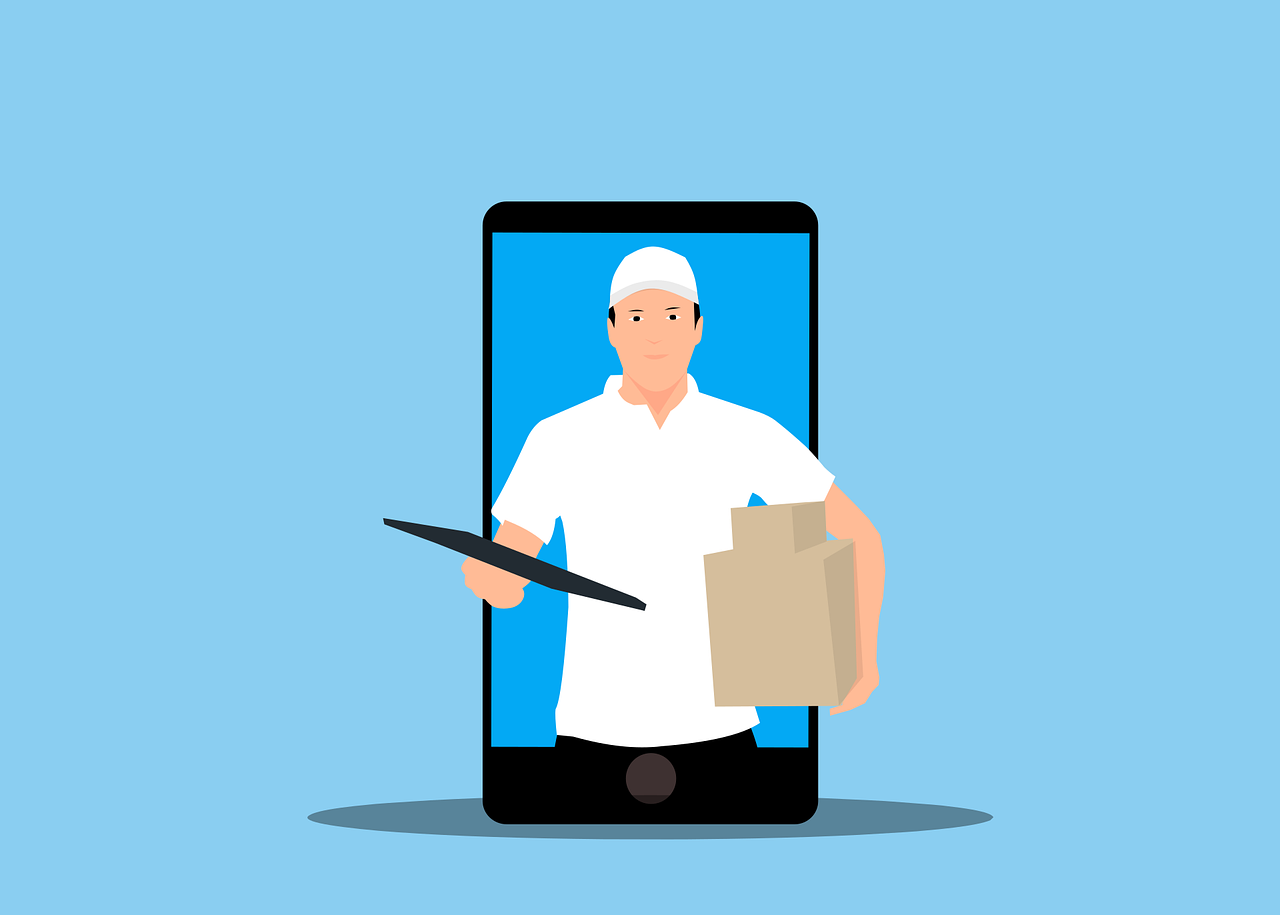
Couriers
Shipping is very important in dropshipping. Fast and safe delivery makes customers come back. Many sellers use third-party logistics (3PL) companies. These companies know about international rules and taxes. They can keep your products in local warehouses. This makes delivery faster. Some couriers and marketplaces, like Amazon and AutoDS, offer quick shipping. Always pick partners with good records and tracking.
Tracking
Customers want to know where their order is. Use suppliers and couriers that give tracking numbers. Real-time tracking helps build trust and lowers complaints. If you use 3PLs, they give you tools to manage orders and returns. Tell customers if there are any delays.
Compliance
Customs
Shipping to other countries means you must follow customs rules. Every country has its own laws for imports and exports. Check if your products are allowed and fill out the right forms. Some items need special certificates or are restricted. If you skip these steps, your packages may get stuck or sent back.
Taxes
Do not forget about taxes and duties. You must pay the right import taxes and follow local tax laws. Some countries want you to collect VAT or GST. Make sure your paperwork is correct and your products have the right labels. This keeps your business legal and stops fines.
Tip: Good logistics help your dropshipping business stand out. If you handle suppliers, shipping, and rules well, you build trust and grow faster—even in new countries.
Growth
Growing your dropshipping business is not just about getting more sales. You need to keep your customers happy and make smart choices using data. Let’s look at how you can use data, keep your customers coming back, and always improve.
Data
Metrics
You cannot grow what you do not measure. Start by tracking key numbers every week. Look at your sales, profit margins, and how much it costs to get a new customer. Check your average order value and how many people come back to buy again. These numbers show you what works and what needs fixing.
Tip: Use cohort analysis to see how different groups of customers behave over time. This helps you spot trends and make better decisions.
Tools
You do not need fancy tools to start. Google Analytics, Shopify reports, and Meta Ads Manager give you lots of useful data. As you grow, try tools like Klaviyo for email, Hotjar for website heatmaps, and inventory apps to track stock. AI and automation tools help you save time and scale faster. They can also help you spot winning products and improve your ads.
Here are some smart ways to use data for growth:
Segment your customers and send them personalised emails.
Test different ads and landing pages to see what gets more sales.
Use supply chain analytics to check supplier speed and stock issues.
Try A/B testing for your checkout process to boost conversions.
Collect feedback with surveys and use it to improve your shop.
Retention
Loyalty
Keeping your customers is cheaper than finding new ones. Set up a loyalty programme to reward repeat buyers. Offer points, discounts, or early access to new products. Personal touches, like thank-you notes or birthday offers, make people feel special. Loyal customers spend more and tell their friends about your shop.
Email is still one of the best ways to keep in touch. Send welcome emails, order updates, and special offers. Segment your list so each customer gets messages that matter to them. Use abandoned cart emails to win back lost sales. Share tips, product guides, and news to keep your brand top of mind.
Improvement
Feedback
Ask your customers what they think. Use quick surveys or ask for reviews after each order. Listen to complaints and fix problems fast. Customer feedback helps you spot weak points and new ideas. When you act on feedback, you show customers you care.
Trends
Stay ahead by watching what’s popular. Use tools to track trending products and keywords. Follow social media to see what your audience likes. Try new products based on what’s hot, but always check if they fit your brand. Keep testing and changing your shop to match what people want.
Note: Dropshipping brands that use data, focus on loyalty, and keep improving often see big jumps in sales and profit. You can do the same by making small changes every week.
Pitfalls
Overextending
It’s easy to get excited when your shop starts making sales. You might want to add more products, try new markets, or spend more on ads. But growing too fast can hurt your business. Many dropshippers fall into this trap. They chase every trend or try to sell everything at once. This often leads to confusion, poor service, and wasted money.
Here are some signs you might be overextending:
You add too many products and lose focus on your main niche.
You spend more on ads than you can afford.
You try to manage too many suppliers at once.
You open new sales channels before your main shop is stable.
Tip: Stick to your best-selling products and build a strong brand first. Only expand when you have the time, money, and systems to handle it.
If you grow too quickly, you risk poor customer support, slow shipping, and unhappy buyers. Take your time. Test new ideas in small steps. Make sure your business can handle more orders before you scale up.
Feedback
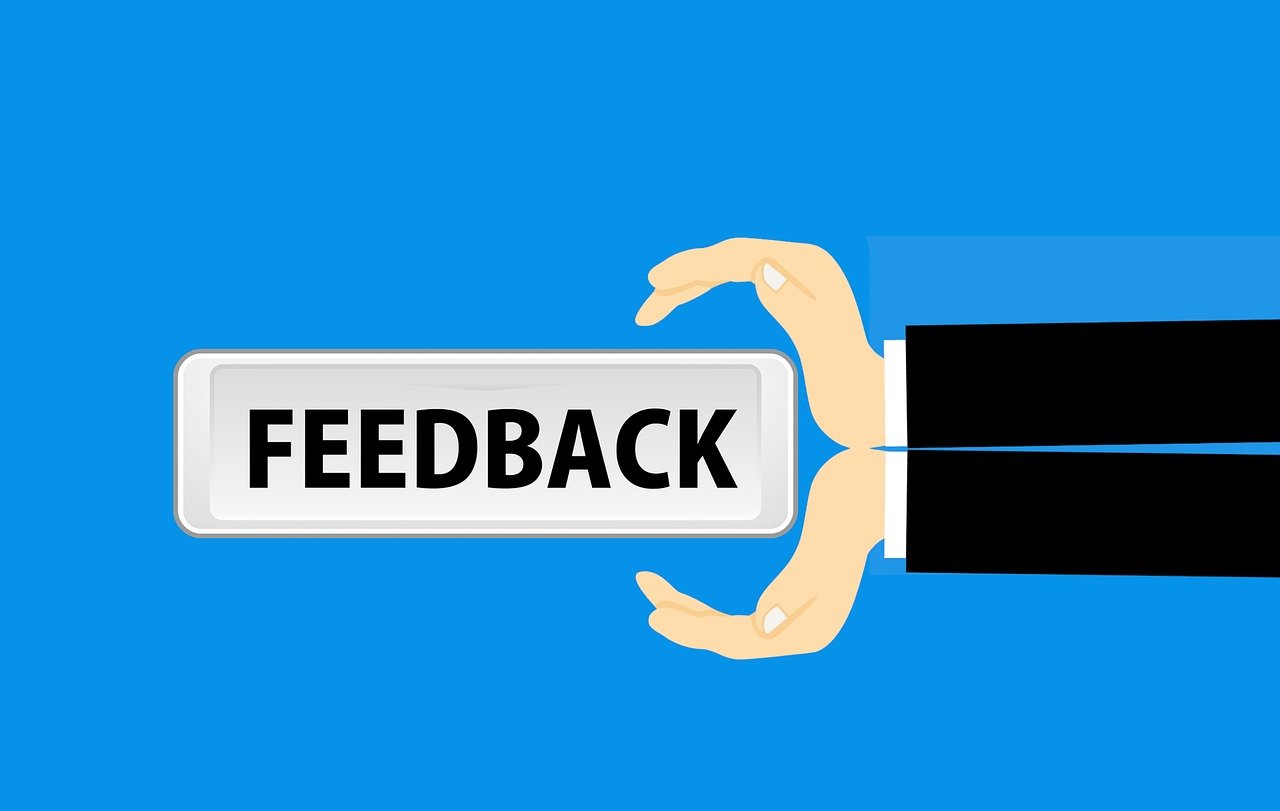
Ignoring feedback is a big mistake in dropshipping. Your customers will tell you what they like and what needs fixing. If you do not listen, you miss out on chances to improve. Bad reviews and complaints can pile up. This hurts your reputation and sales.
Common feedback mistakes include:
Not reading customer reviews or emails.
Deleting negative comments instead of solving the problem.
Failing to ask for feedback after a sale.
Not using feedback to improve your products or service.
You should welcome all feedback, even if it is not what you want to hear. Use it to spot problems early. Fix issues quickly and thank customers for their honesty. When you show you care, people trust your shop more.
Note: Shops that listen to feedback often see more repeat buyers and better reviews.
Logistics
Logistics can make or break your dropshipping business. Many shops fail because they do not manage suppliers, shipping, or stock well. If your products arrive late or in bad shape, customers will not come back. You might also face problems with customs, taxes, or lost parcels.
Here are some common logistics pitfalls:
Picking unreliable suppliers who send poor-quality products.
Not checking shipping times, which leads to delays.
Failing to track orders or update customers.
Ignoring customs rules and taxes for international orders.
A quick checklist for better logistics:
Test your suppliers before you trust them with big orders.
Use tracking numbers for every shipment.
Keep your customers updated about their orders.
Learn the basics of customs and taxes for each country you sell to.
Good logistics keep your customers happy and your business running smoothly. Take time to set up strong systems before you grow.
Legal

Legal mistakes can trip you up fast in dropshipping. Many new shop owners skip the boring legal stuff. You might think you can fix it later, but that can cost you money or even shut down your shop. Let’s look at the most common legal pitfalls and how you can dodge them.
1. Not Registering Your Business
You need to register your business before you start selling. If you skip this step, you might face fines or lose trust with suppliers. Pick a business structure that fits your needs. In the UK, you can choose sole trader, partnership, or limited company. Each one has different rules for tax and paperwork.
2. Missing Legal Pages on Your Website
Every online shop needs legal pages. These include Terms and Conditions, Privacy Policy, and Returns Policy. If you do not have them, you risk breaking the law. Customers also feel safer when they see these pages. You can find free templates online, but make sure they fit your business.
3. Ignoring Product Regulations
Some products need special certificates or safety labels. For example, toys, electronics, and cosmetics have strict rules in the UK and EU. If you sell these without checking the rules, customs might block your orders. Always ask your supplier for proof that products meet local standards.
4. Not Collecting the Right Taxes
You must collect VAT or sales tax if you sell to customers in certain countries. Many dropshippers forget this step. If you do not pay the right taxes, you could get a big bill later. Use tools like Shopify Tax or speak to an accountant to stay on track.
5. Using Copyrighted Images or Content
It’s easy to copy photos or text from other websites. This can get you into trouble. Always use your own images or buy them from stock photo sites. Write your own product descriptions. This keeps your brand safe and helps you stand out.
Tip: Keep a checklist of legal tasks. Tick off each one before you launch your shop. This helps you avoid nasty surprises.
Quick Legal Checklist for Dropshippers:
Register your business and get a tax number.
Add legal pages to your website.
Check product safety rules for your niche.
Collect and pay the right taxes.
Use only original or licensed images and content.
Keep records of all sales and expenses.
If you handle the legal side early, you build trust and keep your business safe. You can focus on growing your shop without worrying about fines or shutdowns.
You have seen how dropshipping can grow from a single sale to a global brand. Every big name started small—just like you. Take action now. Use the tips and tools from this guide. Stay patient and keep learning. Real brands like Gymshark and Grafomap made it by sticking with it.
Review your progress today. Plan your next step. Your international success could be just around the corner.
FAQ
How much money do I need to start dropshipping?
You can start with as little as £300. This covers your website, marketing, and basic tools. If you want to grow faster, you might spend more. Always track your spending from day one.
Can I run a dropshipping business while working or studying?
Yes, you can! Many people start dropshipping as a side hustle. You can work on your shop in the evenings or weekends. Automation tools help you save time.
Do I need to hold any stock?
No, you do not need to keep stock at home. Your suppliers ship products directly to your customers. You focus on marketing and customer service.
What if my supplier makes a mistake with an order?
Mistakes can happen. Contact your supplier quickly and explain the problem. Keep your customer updated. Offer a refund or replacement if needed. Good communication builds trust.
How do I choose the best products to sell?
Look for products with steady demand and low competition. Check reviews and trends. Test a few items before you add more. Use tools like Google Trends or TikTok to spot what’s popular.
Can I sell dropshipping products worldwide?
Yes, you can reach customers in many countries. Check shipping times and customs rules first. Localise your website and offer local payment options. This helps you build trust with buyers everywhere.
Is dropshipping legal in the UK?
Yes, dropshipping is legal in the UK. You must register your business, pay taxes, and follow product safety rules. Add legal pages to your website. If you follow the rules, you can run your shop safely.
Still have questions? Drop a comment below or get in touch. I’m here to help you succeed! 🚀

TangBuy: A Smarter Way to Dropship in 2025
If you're looking to stay competitive with dropshipping in 2025, speed and trend-awareness are key. TangBuy helps you stay ahead with real-time product trends, fast fulfilment, and factory-direct sourcing. With over 1 million ready-to-ship items, 24-hour order processing, and seamless Shopify integration, TangBuy makes it easier to test, scale, and succeed in today's fast-moving eCommerce landscape.
See Also
Complete Guide To Starting A Dropshipping Venture In 2025
Essential Advice For Achieving eBay Dropshipping Success In 2025
How To Successfully Sell Wholesale Products Online In 2025
Ways To Manage Shipping Expenses In Your Dropshipping Business
